Local Pilot Process Evaluation Summary September 2020
This summary report relates to the process learnings gathered between April and September 2020. It set out to understand and explain the extent to which the conditions in the place enable active lives.
Share
Find the Local Pilot process evaluation below. This summary report relates to the process learnings gathered between April and September 2020. It set out to understand and explain the extent to which the conditions in the place enable active lives.
Download the Local Pilot Process Evaluation Summary September 2020 here
In March 2020 the evaluation team presented five prioritised features of system maturity and described theories about how they might enable support for physical activity. These had emerged through a synthesis of local documentation, academic literature, research data and discussion with system stakeholders.
These were:
- Involving local people and growing assets
- Strategic leadership enabling collective leadership
- Effective work across and between sectors,
- Transforming governance and processes; and,
- Learning and adapting
To understand more about features of system working, how and why we think they may support active lives and what we are learning about trying to work in this way you can click on the link embedded in each of the bullets which will take you to an approximate five minute theory illustration.

Involvement of local people and growing assets
- Involving local people remains important to gain insight, increase reach, transfer ownership, and gain influence across the system.
- Relying on one way, only, to engage with local people is open to risk of a) message being diluted or appropriated b) complete breakdown in case of individual illness or capacity.
- Engaging with and nurturing existing groups and forums, where they exist, may provide more stability and ongoing relationships with a wider range of people.
- Committing to ongoing dialogue in partnership with end users and recognising the need for iteration to find approaches that resonate with local people is key to building local capacity to use it.
Key reflection questions
- To what extent are local people currently involved in influencing, designing, or implementing solutions to enable active lives?
- What more could you do to work with local people in your local area on an ongoing basis? What would help this/get in the way of this?
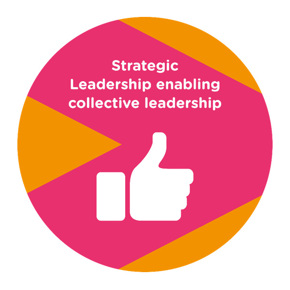
Strategic leadership enabling collective leadership
- Strategic leadership. Sustained and visible support from senior leaders and elected members. Specifically, who:
- work to protect the space for others to do things differently (Protectors), and
- take an active role in promoting physical activity in their sphere of influence (Influencers).
- Collective leadership. Empowering people to make decisions about what works, in the locations they work in, towards a common goal (Believers).
In relation to strategic leadership enabling collective leadership, we learned that:
- Physical activity may well be present in policy and plans for recovery but that LP activity needs to link into this and find the means to leverage influence in the local system beyond the presentation of ‘evidence’, to secure senior level influence, councillor backing and means of raising the voicesof local champions.
- There may be a need to make explicit the “strategy” for collective leadership in some localities. Where this is working there is a spine of influence at different ‘levels’ of the system, radiating outwards into different sectors and communities.
- Leaders throughout the system must have an authentic interest in enabling active lives, subscribe to the principles and ways of working and understand that their role is to be active in support of the common agenda.
- We need to work harder to address capacity issues relating to a) comfort with features of complexity b) messaging around importance of everyday movement and c) confidence and self efficacy to influence.
Key reflection questions
- To what extent are local people currently involved in influencing, designing, or implementing solutions to enable active lives?
- What more could you do to work with local people in your local area on an ongoing basis? What would help this/get in the way of this?
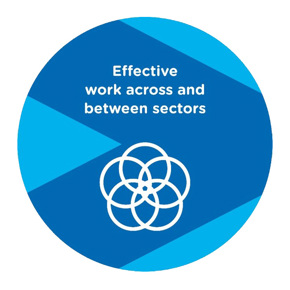
Effective Work Across and Between Sectors
The hypothesised progression of effective collaboration from a broad network was well developed in our last report suggesting the need for a broadening and deepening of trust as potential collaborators work more closely together:
- Broaden and connect the network.
- Align values, principles and common goals.
- Build relationships and trust.
- Work together on common projects.
- Productive partnerships working around common goals.
From our last report, in relation to effective work across and between sectors, we are learning that:
- For effective cross-sector collaboration there needs to be an explicit common purpose or agenda and agreed direction of travel.
- A balance of of quick wins and longer-term goals may make for effective collaboration
- New dynamic models for collaboration may need to be developed based on our emerging understanding of the roles involved in whole systems approaches.
Key reflection questions
- To what extent have you built effective partnership(s) with a common agenda, within the wider aims of the Local Pilot (or whole system approach to physical activity)?
- What are the quick wins which can be tackled in a holistic and robust way? What are the longer-term goals of the partnership?
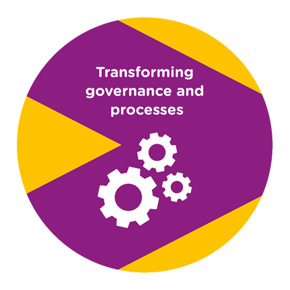
Transforming Governance and Processes
- We have experience of breakthroughs where multiple partners work together but we don’t yet know if this will result in new governance structures which safeguard potential abuses.
- A range of evidence as well as well-formed relationships may allow for progress on legal and procurement issues.
- Full disclosure and local steering group governance can provide proportionate assurance.
Key reflection questions
- What are the governance and administrative processes you had to work around? How have you managed it and what have you learnt? What is still in the way?
- What would enable improved joined-up working?
- How can you develop a system of appropriate accountability in your work?
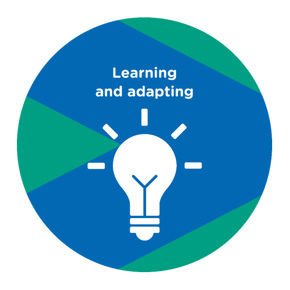
Learning and Adapting
- Covid-19 has created rapidly changing contexts and associated adaptation and this is a mindset we can take forward in the LP work.
- Completely open for a for discussion are not always conducive for critical reflection.
- Telling rich stories and providing more structure, in accessible language, around key features of system change may be more conducive to learning.
Key reflection questions
- What processes are in place (or can you develop) to critically reflect, learn and adapt to enable active lives?
- How are you bringing in insight, data and best practice from elsewhere to support your ongoing practice?
Roles individuals can play within the ‘social movement’ or network
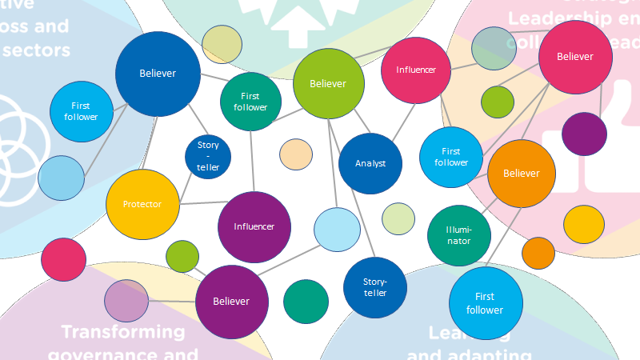
- Believers - people with conviction in the need for physical activity, and a whole system approach, who are able to convey this message with passion.
- First followers – people who are willing to join in and ‘work’ together in new ways to create change. First followers may become believers within their own communities/spheres of influence.
- Protectors and influencers – people, generally with some power afforded by their status, knowledge, resources or job role, who can deploy this power to either protect the space for new ideas and networks to flourish, and/or apply leverage to make conditions easier for people to do so.
- Story-tellers, illuminators and analysts - people who shine a light on the new ways of working, to capture, share and celebrate successes and to gather evidence and insight to inform strategy.
The roles we have identified and illustrate below are underpinned by our observations, interviews and a workshop as well as theoretical models and a body of academic literature (for engaging content on some of these sources, click here Two Loops, Bonds and Bridges). This model has enabled us to consider different perspectives on the work as viewed through the lens of the people who may be involved in it. It should be noted that people may perform different roles at different points in time and for different aspects of the work.
We are encouraging stakeholders to consider whether they have people who perform these roles in their areas of work, and whether they are utilising the skills and resources these people may offer.
Key reflection questions
- Consider the different role(s) you might play in different situations
- Where might there be gaps in your network? How could they be filled?
Downloads
Latest News

What We’re Learning From Place: Reflections From Across Greater Manchester
Nicole McKeating- Jones our Strategic Lead for Place shares her thoughts on the annual reflections of the Place Partnership work across Greater Manchester.

GM Moving pays tribute to Jo Taylor and her role in GM Moving In Action
As we approach the end of 2025, we wanted to take a moment to reflect on some news we had last month.

Nuffield Health research adds to evidence on benefits of exercise programmes
Research carried out by Nuffield Health, Frontier Economics and Manchester Metropolitan University, shows that expanding their programme would generate at least £1.7bn in social and economic value.
